Hours after the World Health Organisation declared the coronavirus outbreak a global pandemic on March 11, Fox News primetime host Sean Hannity pondered the news on his radio show. It “may be true,” he mused to his audience of millions, that “coronavirus fear-mongering by the deep state will go down in history as one of the biggest frauds to manipulate economies, suppress dissent and push mandated medicines.”
Once again, far-right conspiracy theories had broken loose from internet dens and shaped mainstream conservative media coverage. Hannity, a close confidant to President Donald Trump, was parroting a known promoter of QAnon, the online fringe movement that claims a “deep state” cabal of Satanist elites is running an international child sex trafficking ring, among an ever-expanding repertoire of other falsehoods.
The Covid-19 emergency has turbocharged QAnon’s ability to spread tactical disinformation and attract new followers. As the movement seizes on public anxiety surrounding the virus to lure more people into its conspiratorial web, new data compiled by HuffPost reveals shocking spikes in traffic for dozens of the most influential QAnon accounts across social media. Many have more than tripled in size amid the crisis.
With just months until the polls open in November’s presidential election, QAnon has gained a massive new audience for its unhinged propaganda.
“It’s very concerning,” said Alex Kaplan, a senior researcher at Media Matters who studies online extremism. “Whenever a conspiracy theory or falsehood is circulating on social media, you can usually track it to a QAnon figure playing a role in spreading it.”

Skyrocketing Online Interest
QAnon’s ostensible leader is “Q,” an anonymous online poster who adherents believe is a top government insider leaking coded intel to the public. Q posts cryptic messages to the forum 8kun, which replaced the now-shuttered website 8chan last fall. There’s no clear indication of how many subscribers QAnon has amassed since its origins in 2017, although researchers estimate that its base could comprise hundreds of thousands of people or more – including at least 57 current and former congressional candidates. Some QAnon followers have even been inspired to commit violent crimes.
Rather than getting their supposed intel directly from Q on 8kun, which can be difficult to navigate, many QAnon supporters rely on a network of so-called “decoders,” or proxy figures, who decipher and extrapolate on Q’s posts on their various social media channels. Whenever QAnon content scores a prominent new endorser, a trending hashtag, an affirming feature on Fox News or a presidential retweet, for example, decoders’ Twitter, YouTube, Instagram and Facebook pages tend to light up with curious new followers seeking information about the movement.
That’s been happening a lot lately, particularly as people search for answers about a global health emergency that’s unprecedented in most living memories. QAnon has played a major role in amplifying Covid-19 conspiracy theories into virality – many stemming from the baseless claim that the virus is a state-engineered bioweapon – while attracting hordes of new adherents in the process.
HuffPost analysed the growth of dozens of the largest QAnon decoder accounts on social media, using the analytics tools Social Blade and CrowdTangle. The data showed explosive spikes in followers and subscribers starting in mid-March, just as the outbreak reached official pandemic status and as much of the world awoke to its severity. Most accounts’ followings have grown at least threefold since March 11, with one QAnon-centric Facebook group’s membership skyrocketing by more than 5,000%.
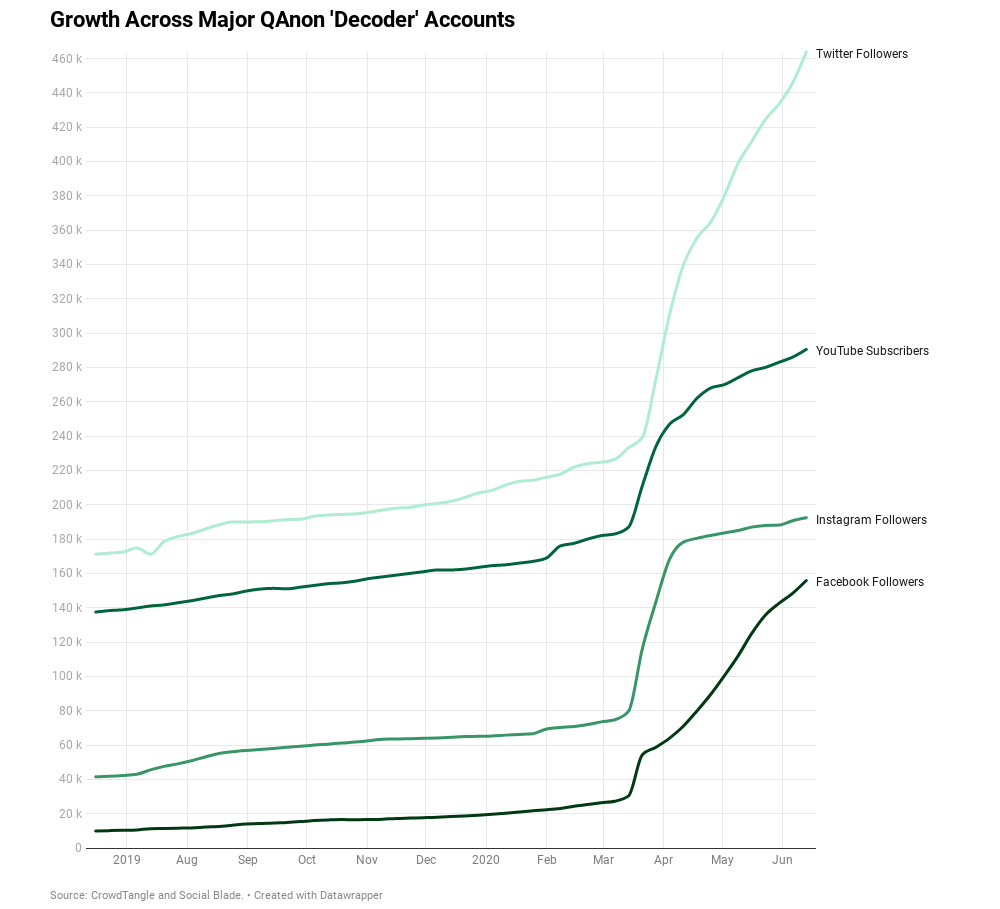
Google searches for “QAnon” also began to soar in mid-March, as Mother Jones reported, along with searches for “deep state”; “Fall of the Cabal,” a popular QAnon video explainer series; and “WWG1WGA,” the movement’s slogan, meaning “Where We Go One, We Go All.” The number of visits to qmap.pub, a website that catalogs Q’s posts, has likewise erupted during the pandemic. The page had more than 10.5 million hits in May, compared to 4.1 million in January, according to the analytics tool SimilarWeb.
This surge in traffic appears to represent a staggering wave of new interest in QAnon. Although it may seem like a bizarre, low-level threat given its #PizzaGate-style theories, QAnon has an outsize real-world impact. As it has bubbled up from the paranoiac cesspools, it has shown time and again its insidious ability to disseminate disinformation to the masses – including, recently, anti-vaccine propaganda, the promotion of bleach as a Covid-19 cure, and hoaxes targeting front-line health care workers.
Even before the virus took its toll, QAnon had staked its territory in the political realm. Time magazine listed Q among the most influential people on the internet in 2018. A 2019 Civiqs poll of 1,543 registered U.S. voters found that 17% considered QAnon’s theory “about a conspiracy among deep state elites” to be “mostly true.” Last spring, following a deadly shooting and other violent incidents involving self-proclaimed QAnon believers, the FBI labeled the movement a potential domestic terrorism threat. Trump has retweeted QAnon-supporting accounts more than 130 times – including three times on Saturday alone. And now, an open QAnon promoter is expected to make it to Congress.

The pandemic has provided the ideal conditions for QAnon to gain critical mass. Fear and desperation abound in times of crisis, and rapidly changing information – such as the shifting advice regarding face masks early on – can rattle people’s confidence in authoritative news sources, rendering them especially vulnerable to conspiracy theories.
“People are looking for explanations for what feels like randomness,” Kaplan said. Conspiracy theorists are ready and eager to meet that demand.
The coronavirus has even brought unlikely QAnon enthusiasts out of the woodwork to preach Q’s message to entirely new audiences. Over the past three and half months, a series of lifestyle influencers on Instagram have abruptly pivoted their content from fashion, yoga, filtered selfies and the like to far-right agitprop.
“With everything going on in the world, I’m ready to share some of the things that I have been following for a really long time that I think are going to be exposed to the masses very soon,” one influencer-turned-propagandist announced in March, before posting a series of QAnon-themed Story Highlights to “awaken” her more than 100,000 followers.
Since then, she has repeatedly used her platform to advance the notion that the pandemic is a false flag event orchestrated to distract from “deep state” depravity, to mandate vaccines and, more generally, to exert unbridled control over society.
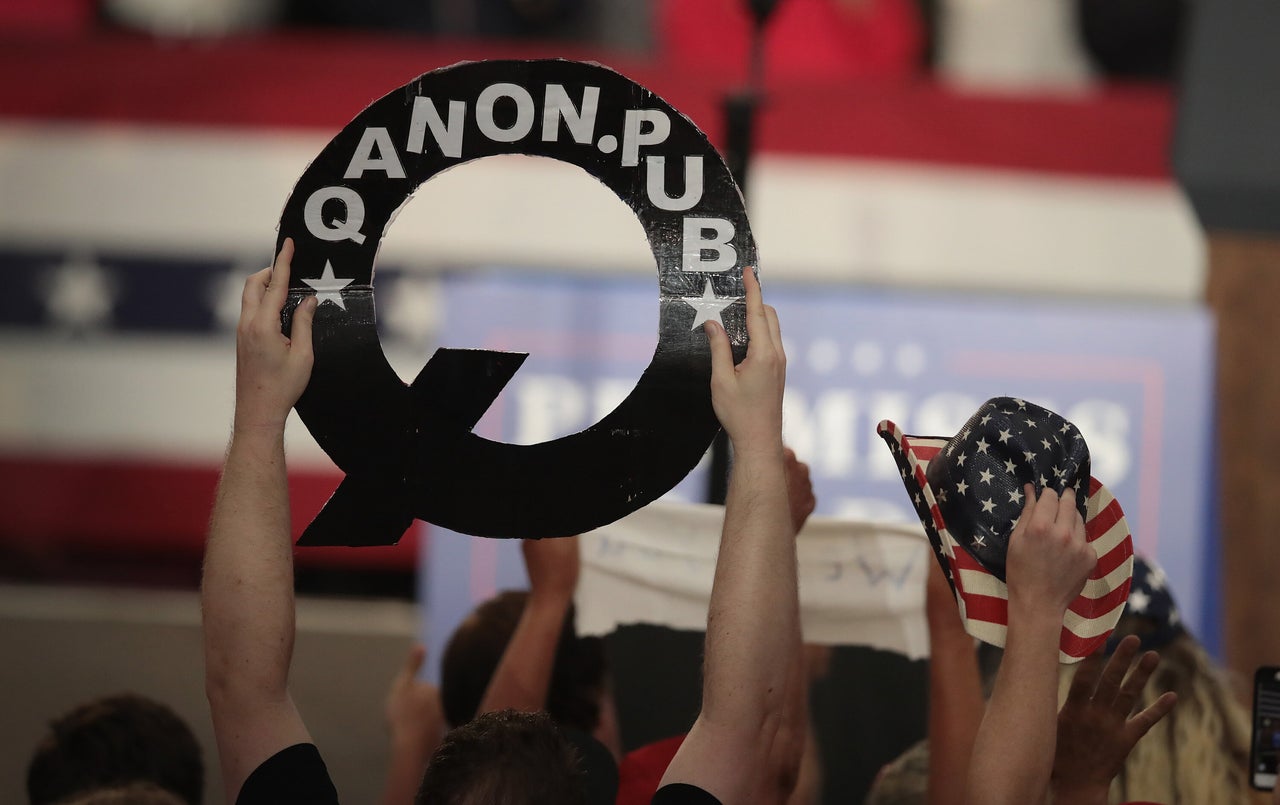
A Burgeoning Force For Disinformation
QAnon’s growth is self-perpetuating: As it gains more followers, its ability to sow confusion and hyper-partisan conspiracies gets stronger, helping it attract even more adherents. This cycle is also fuelled by social media recommendation engines that drive QAnon content onto people’s screens.
One of the highest-profile examples of coronavirus disinformation is “Plandemic,” the professionally produced but falsehood-laden film featuring discredited former medical researcher Judy Mikovits. Pushing a series of debunked claims, including that wearing face masks “literally activates your own virus” (it doesn’t) and that vaccines are “a money-making enterprise that causes medical harm” (they’re not), “Plandemic” went viral almost overnight – and it happened in large part because of QAnon.
Disinformation researcher Erin Gallagher traced the film’s spread across Facebook and other video-hosting websites. She found that a handful of big QAnon Facebook groups were among “Plandemic’s” most effective promoters on the 2.6 billion-user platform.
These “super spreader” groups can behave like a virus in the way that they propagate false information, Gallagher told HuffPost. “A lot of people come into contact with content there, and are sharing it in and out of the group,” she said.
One QAnon group played a particularly large role in amplifying “Plandemic,” Gallagher’s research showed. That’s likely because the group has been rapidly expanding since mid-March, like so many other major QAnon social media pages. By the time the video was posted online in early May, the group had already swelled from around 3,300 members pre-pandemic to nearly 120,000. (It’s now closing in on 200,000.)
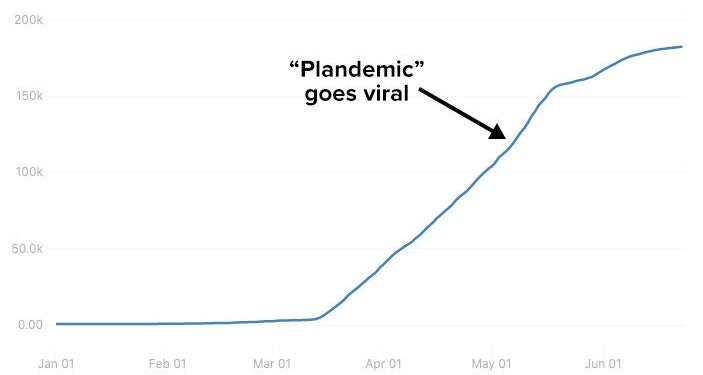
Social media algorithms have undoubtedly accelerated the growth of QAnon accounts on their respective platforms. Facebook and other websites are free to use in exchange for people’s attention, which is the commodity that is then sold to advertisers. So when algorithms detect that certain content has the potential to go viral – whether it relates to the Kardashians, baby animals or a “deep state” cabal of Satan-worshipping pedophiles – they’ll often promote it further to prolong user engagement and maximise ad revenue.
By following just a single QAnon account on Instagram, for example, users can wind up viewing dozens more – all served to them by an app that’s designed to keep them scrolling for as long as possible, even if it means distributing disinformation. Facebook, which owns Instagram, has run dozens of ads featuring the “WWG1WGA” slogan.
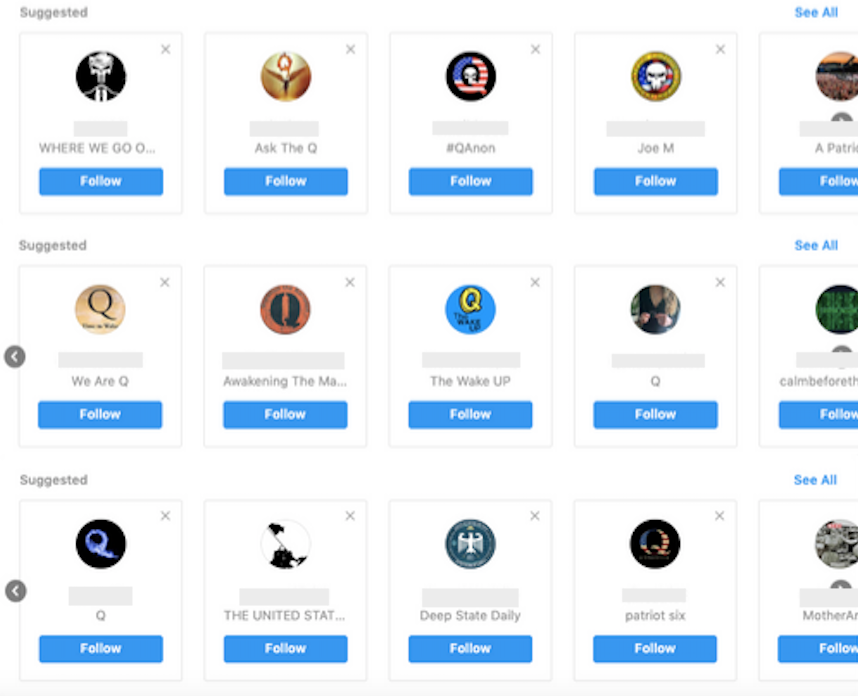
In rewarding such content with algorithmic promotion, social media platforms not only legitimize it, but incentivize people to produce more of it.
“Recommendation and engagement algorithms are built to promote this kind of content,” said Gallagher, who was shocked to see Facebook recommend that she check out a QAnon page in April right after she joined a local quarantine-focused group. “They’re built for viral marketing campaigns.”
With Big Tech’s help, QAnon has propagated many of the biggest conspiracy theories that are now plaguing society, and as the movement grows its reach, it’s only becoming more adept at doing so.
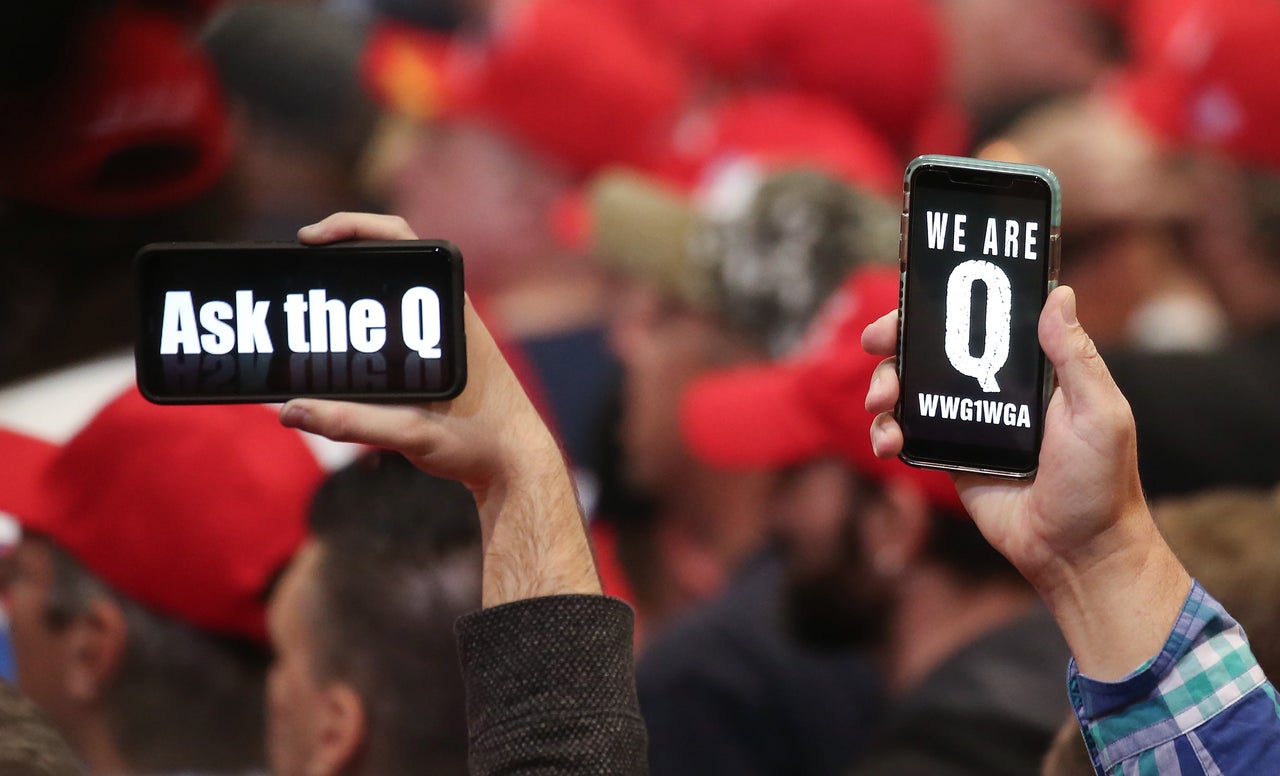
Conservative Media Pickup
As QAnon has wormed its way to notoriety from the entrails of the internet, it has become an increasingly effective conspiracy-theory pipeline to much bigger figures in the right-wing ecosystem. Since elevating the claim about coronavirus fear-mongering by the “deep state” all the way up to Hannity’s radio show in March, QAnon has helped blast out a litany of other terrifying falsehoods tied to COVID-19, including the widespread assertion that the vaccine, when it arrives, will be used for mind control.
The amplification and reach of these theories has impeded the work of public health officials tackling the worst pandemic in a century.
On March 23, Q posted a message to 8kun suggesting that the coronavirus was a bioweapon unleashed to hurt Trump’s re-election chances. Days later, the hashtag #FilmYourHospital started trending on Twitter. Launched by a QAnon supporter, it urged people to show up at health care facilities with cameras in an attempt to expose the media for supposedly exaggerating the extent of the crisis. (More than 125,000 Americans have died from Covid-19 so far.) Former congressional candidate DeAnna Lorraine Tesoriero, a notorious QAnon promoter, tweeted the #FilmYourHospital challenge to her more than 300,000 followers.
In early April, another QAnon-backed conspiracy theory got a boost from Fox News. After QAnon supporters aggressively pushed the baseless claim that Microsoft founder Bill Gates – who is helping to fund Covid-19 vaccine development efforts – will somehow implant people with microchips for tracking and depopulation purposes, Fox’s Laura Ingraham quote-tweeted a post about Gates and vaccines, writing: “Digitally tracking Americans’ every move has been a dream of the globalists for years. This health crisis is the perfect vehicle for them to push this.”
Later that month, QAnon found an even greater megaphone in the president of the United States. Throughout the crisis, QAnon backers including Tesoriero have been calling on Trump to replace leading infectious-diseases specialist Dr. Anthony Fauci with Shiva Ayyadurai, a Senate GOP candidate and scientist who is staunchly opposed to vaccines, and who has promoted QAnon in the past. As the government had to enhance Fauci’s security detail in response to far-right harassment, an April 10 YouTube video of Ayyadurai accusing Fauci of being “embedded in the deep state” racked up millions of views. Two days later, the trending hashtag #FireFauci was retweeted by Trump himself.
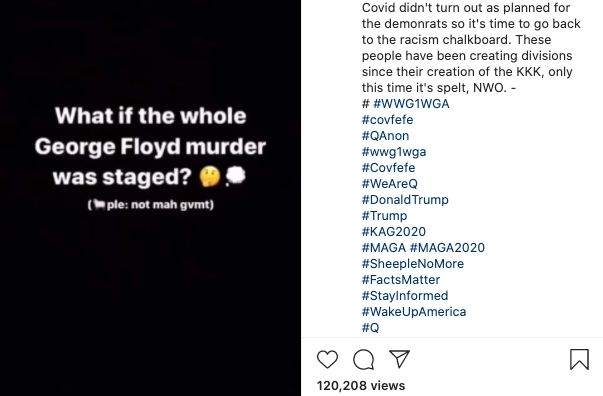
Now, QAnon is wielding its bolstered momentum to propel fake news about the killing of George Floyd into the mainstream – exacerbating a national tragedy while displaying its own prowess as a purveyor of disinformation in the run-up to the presidential election.
QAnon decoders have argued that Floyd’s death was a scam intended to provoke chaos and justify a sweeping government crackdown. A 22-minute YouTube video pushing that falsehood was widely shared in QAnon Facebook groups and reached at least 1.3 million people, The New York Times reported earlier this month. A short time later, a woman in California was filmed tearing down a public memorial for Black victims of police violence as she shouted that Floyd’s death was “staged by antifa and George Soros.”
More recently, QAnon adherents have accused the Black Lives Matter movement of being a front to launder money for Democrats – a debunked claim that was started by a QAnon Twitter account, according to a review by Media Matters. It garnered extraordinary online traction from a number of prominent right-wing pundits, including Fox News host Jesse Watters on Saturday evening.
“I wonder how much Black Lives Matter funnelled to [Democratic presidential nominee Joe] Biden just in June alone,” Watters said on his show, “Watters’ World,” which has millions of viewers. Trump retweeted a clip of the segment soon after it aired.
Late Sunday night, Fox News commentator Tomi Lahren tweeted then deleted a picture of a flyer falsely attributed to Black Lives Matter that labeled white men, women and children “the enemy.” Snopes, which had already debunked the hoax as an “attempt to smear” the racial justice movement almost two weeks earlier, reported that the flyer appeared to originate from a QAnon Twitter account.
QAnon decoders and supporters were also involved early on in spreading the entirely unfounded rumour that Martin Gugino – the 75-year-old protester who was violently pushed to the ground by police in Buffalo, New York, fracturing his skull – was an antifa activist who faked his injuries. Far-right media outlet One America News Network ran with the conspiracy theory, and within days of the incident, Trump caught wind.
“Buffalo protester shoved by Police could be an ANTIFA provocateur,” the president tweeted to his 82 million followers, as Gugino lay in a hospital bed with a brain injury.
“Could be a set up?”